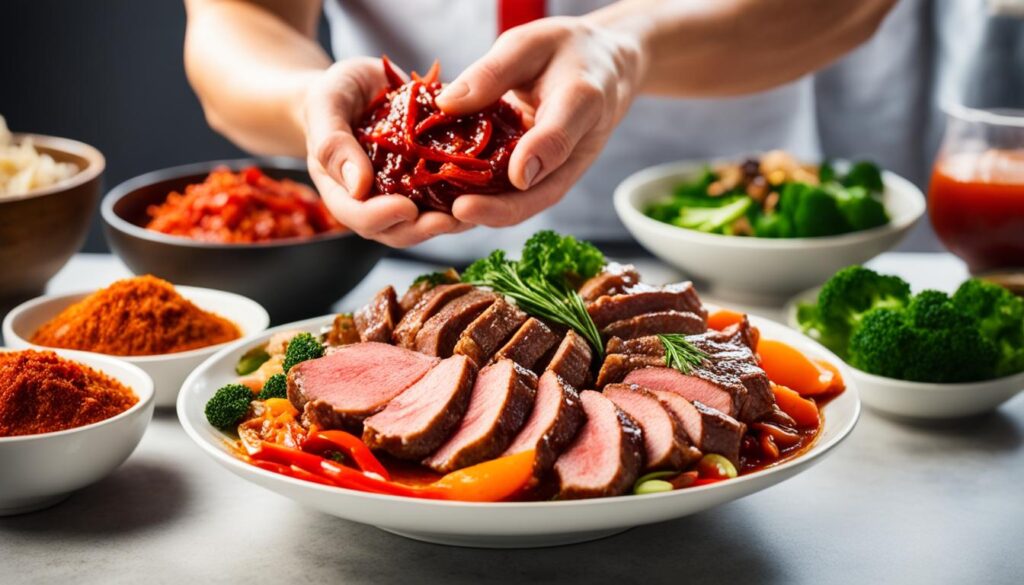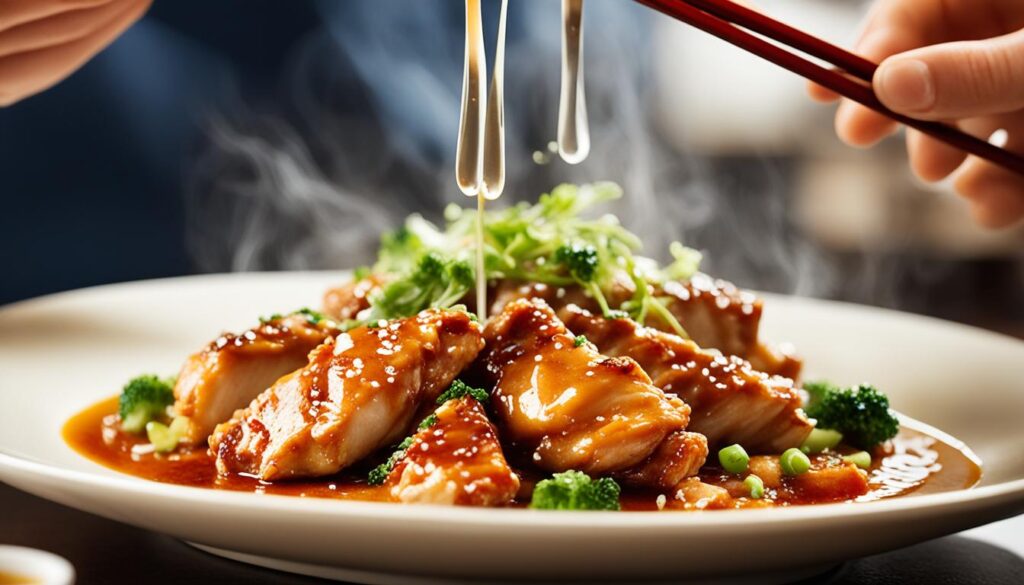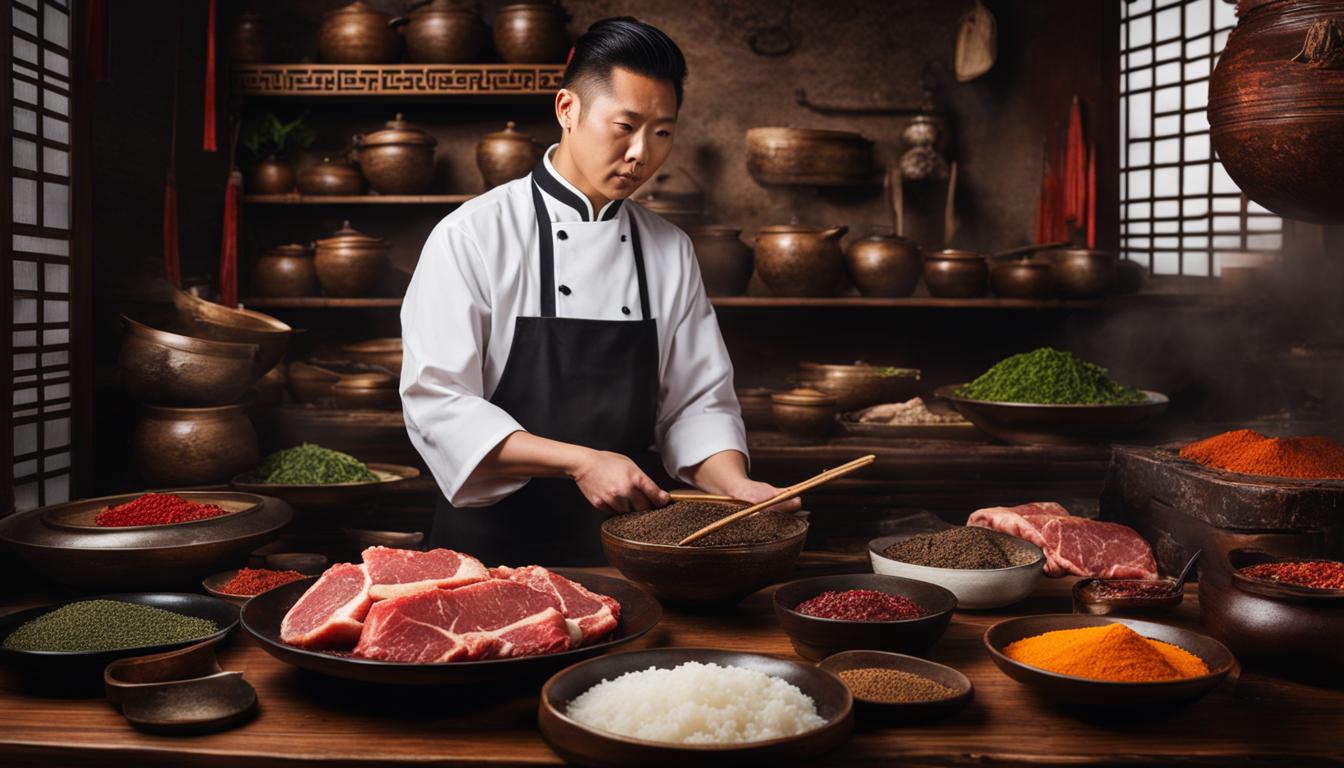Welcome to our guide on water velveting, a traditional Chinese cooking technique that is sure to transform your stir-fry dishes. Have you ever wondered how Chinese cuisine achieves that tender and succulent meat? Well, the secret lies in the art of water velveting.
Chinese velveting is a culinary technique that involves marinating meat in a mixture of cornstarch, oil, egg whites, Shaoxing wine, and salt, followed by a brief cooking process to seal in the juices and create a velvety texture. This technique is widely used in Chinese cuisine, particularly in stir-fry dishes, to ensure that the meat remains flavorful, moist, and tender.
Water velveting can be applied to various proteins, including shrimp, chicken, beef, and tofu. It is a versatile technique that adds an extra layer of flavor and texture to your dishes. By mastering the art of water velveting, you can elevate your Chinese-inspired creations to a whole new level.
Join us as we delve into the world of Chinese velveting, discussing what it is, how to velvet meat for Chinese dishes, the benefits of water velveting, its role in Chinese cuisine, tips for successful velveting, and even other uses of this incredible technique. Get ready to unlock the secrets of water velveting and take your cooking skills to the next level!
What is Chinese Velveting?
Chinese velveting is a traditional cooking technique that originated in China. It involves marinating raw meat in a mixture of ingredients like cornstarch, oil, egg whites, Shaoxing wine, and salt. The marinated meat is then cooked briefly to seal in the juices and create a tender texture.
This technique is used in various Chinese dishes, especially stir-fries, to ensure that the meat is flavorful, moist, and tender. The velveting process creates a protective coating around the meat, preventing it from drying out during cooking.
By marinating the meat in a combination of ingredients, the meat becomes coated in a flavorful mixture that enhances its taste and texture. The cornstarch in the marinade helps to tenderize the meat, while the oil and egg whites create a velvety texture. The Shaoxing wine adds a rich and complex flavor, while the salt helps to season the meat.
The velveting process is a crucial step in Chinese cooking techniques as it ensures that the meat remains juicy and flavorful, even after being cooked at high heat. It is the secret behind the perfectly tender and succulent meat found in Chinese stir-fried dishes.
The velveting process begins with marinating the meat in the mixture for a specific duration, allowing the flavors to penetrate and tenderize the meat. The exact marinating time varies depending on the type of meat you’re using, with thinner slices requiring less time compared to thicker cuts.
After marinating, the meat is briefly cooked in boiling water or hot oil. This step serves to seal in the juices and create a protective coating around the meat, resulting in a tender and succulent texture. It is important to note that the cooking time should be kept short to prevent overcooking and maintain the desired tenderness.
Chinese velveting can be applied to a variety of proteins, including shrimp, chicken, beef, and tofu. Each protein may require slight variations in the marinade ingredients or cooking time, but the fundamental process remains the same. The goal is to achieve tender and flavorful meat that complements the other ingredients in the dish.
Overall, Chinese velveting is a fundamental technique in Chinese cuisine that allows for the creation of delicious and mouthwatering dishes. Its ability to produce tender and succulent meat makes it a staple in stir-fried dishes and a must-know skill for any aspiring Chinese chef.
| Chinese Velveting Process | Benefits of Chinese Velveting |
|---|---|
| – Marinate raw meat with cornstarch, oil, egg whites, Shaoxing wine, and salt | – Seals in the juices, resulting in tender and succulent meat |
| – Cook the marinated meat briefly in boiling water or hot oil | – Prevents the meat from drying out during cooking |
| – Enhances the flavor and texture of the meat | |
| – Allows for the use of less oil in cooking |
Learn more about the technique of water velveting in Chinese cuisine in our upcoming sections.
How to Velvet Meat for Chinese Dishes
To velvet meat for Chinese dishes, we need to follow a specific method known as the Chinese velveting technique. This technique ensures that the meat is tenderized, resulting in a juicy and flavorful dish. Here’s how you can velvet meat for Chinese dishes:
- Prepare the marinade mixture by combining cornstarch, oil, egg whites, Shaoxing wine, and salt in a bowl. Mix well until all the ingredients are fully incorporated.
- Add the raw meat to the marinade, making sure that each piece is coated evenly. You can use proteins like chicken, beef, shrimp, or tofu for Chinese dishes.
- Allow the meat to marinate in the refrigerator for at least 30 minutes. This allows the flavors to penetrate the meat and tenderize its texture.
-
After marinating, you have two options for cooking the meat:
- Boiling Water Method: Bring a pot of water to a boil and add the marinated meat. Cook for a few minutes until the meat changes color and becomes opaque. Remove the meat from the water and drain.
- Hot Oil Method: Heat oil in a wok or deep-frying pan until it reaches a high temperature. Carefully add the marinated meat to the hot oil and cook for a few minutes until it is cooked through. Remove the meat from the oil and drain the excess oil.
- Use the velveted meat in your Chinese dishes, such as stir-fries or noodle dishes. The velveting process locks in the juices, resulting in tender and succulent meat.
Adjust the cooking time based on the type of meat you are using. Remember, the goal is to cook the meat briefly to seal in the juices and create a velvety texture.

The image above visually represents the steps involved in velvetting meat for Chinese dishes.
Benefits of Water Velveting
Water velveting is a popular method used in Chinese cooking to achieve tender and flavorful meat. By marinating the meat in a mixture of cornstarch, oil, egg whites, Shaoxing wine, and salt, and briefly cooking it in boiling water or hot oil, water velveting offers several benefits that make it a preferred technique for stir-frying:
- Enhanced tenderness: Water velveting results in meat that is incredibly tender and juicy. The marinade helps break down the proteins in the meat, resulting in a velvety texture that melts in your mouth.
- Retained moisture: One of the main benefits of water velveting is that it seals in the natural juices of the meat, preventing it from drying out during stir-frying. This ensures that the meat remains succulent and flavorful.
- Faster cooking times: Water velveting pre-cooks the meat, reducing the stir-frying time significantly. This not only saves time in the kitchen but also helps retain the natural flavors and nutrients of the ingredients.
- Improved flavor absorption: The marinade used in water velveting enhances the flavor of the meat by infusing it with a delicious combination of ingredients. This results in meat that is tastier and more flavorful in every bite.
- Healthier cooking method: Water velveting requires very little oil compared to traditional stir-frying methods. This makes it a healthier option for those looking to reduce their oil intake without compromising on taste.
Water velveting is the secret to achieving restaurant-quality stir-fry dishes at home. The technique’s ability to tenderize meat, retain moisture, and enhance flavors makes it a valuable skill to master in Chinese cooking.
Velveting in Chinese Cuisine
Velveting is a common technique used in Chinese cuisine to achieve tender and flavorful meat. Chinese chefs have mastered the art of velveting to ensure that the meat in their dishes stays moist, tender, and full of flavor.
This technique is particularly popular in stir-fry dishes, where the quick cooking process can easily result in tough and dry meat. By using the velveting technique, Chinese chefs are able to maintain the juiciness of the meat and create a velvety texture that gently coats the protein.
Velveting in Chinese cuisine is a versatile technique that can be applied to various proteins such as shrimp, chicken, beef, and even tofu. It involves marinating the protein in a mixture of ingredients like cornstarch, oil, egg whites, Shaoxing wine, and salt. This marinade helps to tenderize the meat and enhance its flavor.
After marinating, the meat is typically briefly cooked in boiling water or hot oil. This step seals in the juices and further enhances the tenderness of the meat. The velveting process creates a protective coating around the meat, preventing it from drying out during the high heat cooking of stir-frying.
Velveting is considered one of the essential techniques in Chinese cooking. Mastering the art of velveting allows chefs and home cooks to elevate the texture and taste of their dishes. Whether you’re making a classic chicken stir-fry or a seafood medley, using the velveting technique will ensure that your meat is tender, succulent, and bursting with flavor.
Benefits of Velveting in Chinese Cuisine:
- Retains moisture: The velveting technique helps to seal in the natural juices of the meat, resulting in moist and succulent protein.
- Creates a tender texture: Velveting tenderizes the meat, making it easier to chew and enjoy.
- Enhances flavor: The marinade used in the velveting process infuses the meat with delicious flavors, elevating the overall taste of the dish.
- Improves cooking consistency: By velveting the meat, you can achieve consistent results every time, ensuring that the meat is cooked evenly.
- Versatile technique: Velveting can be applied to various proteins, allowing you to create a wide range of flavorful dishes.
With its ability to transform the texture and flavor of meat, velveting is an essential technique in Chinese cuisine. Whether you’re a professional chef or an adventurous home cook, mastering the art of velveting will elevate your Chinese dishes to a whole new level.
Tips for Successful Water Velveting
To achieve successful water velveting, here are some tips to keep in mind:
1. Choose the Right Meat
Not all types of meat are suitable for water velveting. Opt for lean cuts like chicken breast, beef tenderloin, or shrimp, as they will yield the best results. Trim off any excess fat before marinating for a healthier option.
2. Marinate Adequately
The key to tender and flavorful meat lies in the marinade. Ensure that each piece of meat is evenly coated with the marinade mixture. Let it marinate in the refrigerator for at least 30 minutes to allow the flavors to penetrate and the texture to become tender.
3. Get the Water Boiling
When it’s time to cook the meat, make sure the water is boiling rapidly. This will help to seal in the juices quickly and create a velvety texture. Avoid overcrowding the pot to maintain the water temperature. Cook the meat for the recommended time, depending on the protein you are using. Consult the table below for specific cooking times.

| Protein | Cooking Time |
|---|---|
| Chicken Breast | 2-3 minutes |
| Beef Tenderloin | 1-2 minutes |
| Shrimp | 1-2 minutes |
4. Use High Heat
After boiling, give the meat a quick rinse under cold water to remove any excess starch. It’s essential to use high heat when stir-frying the velveted meat. This will help to lock in the flavors and create a smoky wok hei aroma.
5. Avoid Overcooking
Water velveting is all about achieving tender and succulent meat. Be mindful not to overcook the velveted meat in subsequent steps, as it can result in a tough texture. Add the velveted meat towards the end of the stir-fry and cook it just until it’s heated through.
By following these tips, you can master the art of water velveting and create delicious Chinese dishes with tender and velvety meat every time.
Other Uses of Velveting Technique
While water velveting is commonly associated with Chinese cuisine, the velveting technique can be used in various dishes and cuisines. In addition to Chinese stir-fries, velveting can be applied to other proteins like chicken, beef, or tofu to achieve a tender and juicy texture.
The basic principle of velveting remains the same – marinate the meat and cook it briefly to seal in the juices. By employing velveting, you can elevate the quality of your dishes and ensure that the protein stays moist and tender, regardless of the cuisine you’re preparing.
The velveting technique offers a versatile approach to cooking, allowing you to experiment with different marinade ingredients and flavors to suit your palate. Whether you’re preparing a flavorful chicken stir-fry, a succulent beef dish, or a vegetarian tofu stir-fry, velveting can enhance the taste and texture of your meal.
To demonstrate the various applications of the velveting technique, here are some examples of how it can be used in different cuisines:
1. Asian-Inspired Dishes
In addition to Chinese cuisine, velveting can be incorporated into various Asian-inspired dishes. For example, in Thai cooking, velveting can be utilized to prepare tender and moist chicken for stir-fried Thai basil or Thai green curry. Similarly, in Korean cuisine, velveting can be employed to achieve juicy and flavorful meat for dishes like bulgogi or bibimbap.
2. Western-Style Stir-Fries
While stir-fry is typically associated with Asian cuisine, you can adapt the velveting technique to create Western-style stir-fries. For instance, you can velvet beef and vegetables to make a savory beef stir-fry with broccoli and mushrooms. The velveting process ensures that the beef remains tender, making it a delightful addition to your Western-inspired stir-fries.
3. Mediterranean Delights
The velveting technique can even be applied to Mediterranean dishes. For instance, you can velvet chicken or tofu to prepare a flavorful Mediterranean stir-fry with ingredients like onions, bell peppers, and olives. The velveting process helps to lock in the flavors and keep the protein moist, resulting in a deliciously satisfying Mediterranean-inspired meal.
Overall, the versatility of the velveting technique allows you to explore and experiment with different cuisines, bringing a touch of tenderness and juiciness to your dishes. Whether you’re preparing Asian-inspired stir-fries, Western-style dishes, or Mediterranean delights, velveting can be a valuable skill to enhance the flavor and texture of your meals.
| Cuisine | Recommended Proteins | Example Dish |
|---|---|---|
| Thai | Chicken | Thai Basil Chicken Stir-fry |
| Korean | Beef | Bulgogi |
| Western | Beef, Chicken, Tofu | Beef Stir-fry with Broccoli and Mushrooms |
| Mediterranean | Chicken, Tofu | Mediterranean Stir-fry |
Conclusion
Water velveting is a traditional Chinese cooking technique that has revolutionized the way we prepare meat for stir-fry dishes. By marinating the meat in a mixture of cornstarch, oil, egg whites, Shaoxing wine, and salt, we can elevate the flavor and texture of our dishes to new heights. The velveting process locks in moisture and creates a velvety texture, resulting in tender and succulent meat that melts in your mouth.
One of the major benefits of water velveting is the enhanced flavor it brings to our dishes. As the meat marinates, the flavors infuse into every fiber, resulting in a more intense and delightful taste. Furthermore, water velveting improves cooking consistency by ensuring that the meat cooks evenly and stays tender throughout the cooking process. This technique is particularly useful when working with proteins that tend to dry out easily, such as chicken or beef.
Not only does water velveting enhance the flavor and texture of our dishes, but it also allows us to use less oil in our cooking. By briefly cooking the meat in boiling water or hot oil, we can achieve the desired velvety texture without excessive oiliness. This makes our dishes healthier without compromising on taste.
In Chinese cuisine, velveting is considered an essential technique that every cook should master. It can be used with various proteins like shrimp, chicken, beef, and tofu, making it a versatile skill that opens up a world of culinary possibilities. With these tips and techniques, you can confidently velvet meat for your Chinese dishes and impress your family and friends with tender and flavorful creations.
